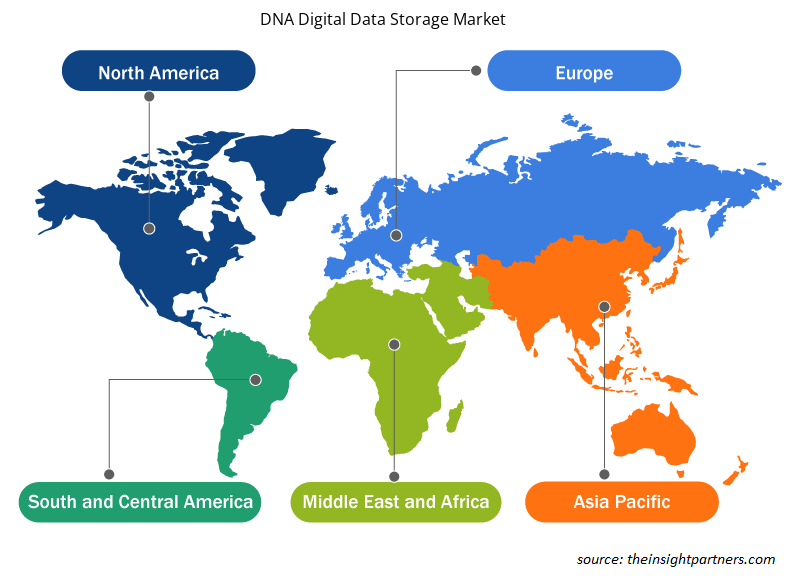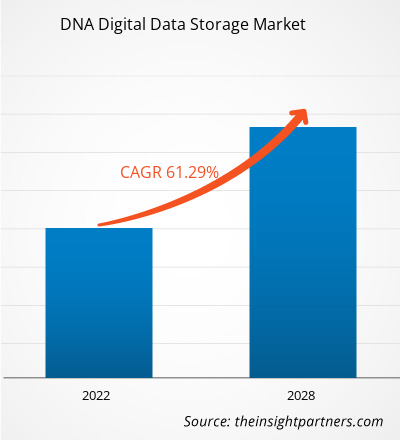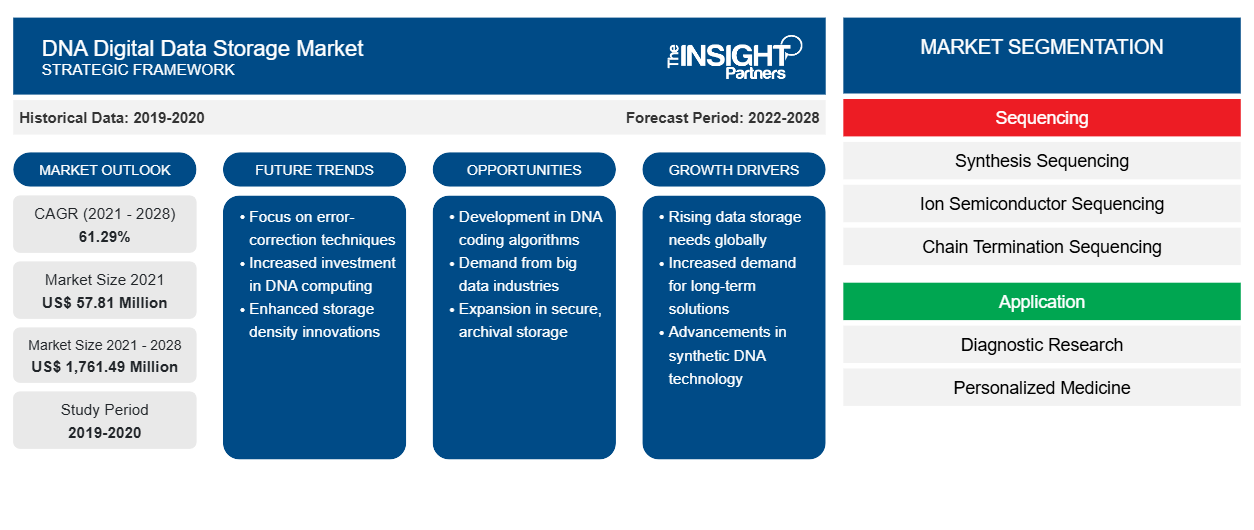من المتوقع أن ينمو سوق تخزين البيانات الرقمية DNA من 57.81 مليون دولار أمريكي في عام 2021 إلى 1،761.49 مليون دولار أمريكي بحلول عام 2028؛ ومن المتوقع أن ينمو بمعدل نمو سنوي مركب قدره 61.29٪ خلال الفترة من 2021 إلى 2028.
تخزين البيانات الرقمية باستخدام الحمض النووي هو طريقة ترميز وفك تشفير البيانات الثنائية من وإلى خيوط الحمض النووي المركبة. وقد اكتسب الحمض النووي اهتمامًا باعتباره وسيلة لتخزين المعلومات الرقمية نظرًا لكثافة تخزينه العالية ومتانته التي تفوق تلك الموجودة في وسائط التخزين القائمة على السيليكون. علاوة على ذلك، يوفر رمز النوكليوتيدات المكون من أربعة أحرف في الحمض النووي بيئة ترميز مناسبة يمكن استخدامها بنفس الطريقة التي تستخدم بها أجهزة الكمبيوتر والأجهزة الكهربائية الأخرى رمزًا رقميًا ثنائيًا لتمثيل أي حرف أو رقم أو أي حرف آخر.
قم بتخصيص هذا التقرير ليناسب متطلباتك
ستحصل على تخصيص لأي تقرير - مجانًا - بما في ذلك أجزاء من هذا التقرير، أو تحليل على مستوى الدولة، وحزمة بيانات Excel، بالإضافة إلى الاستفادة من العروض والخصومات الرائعة للشركات الناشئة والجامعات
- احصل على أهم اتجاهات السوق الرئيسية لهذا التقرير.ستتضمن هذه العينة المجانية تحليلاً للبيانات، بدءًا من اتجاهات السوق وحتى التقديرات والتوقعات.
العوامل التي تدفع نمو سوق تخزين البيانات الرقمية DNA العالمية هي وجود مقدمي خدمات تخزين البيانات الرقمية DNA والاستثمارات النشطة والابتكار التجاري المتعلق بتخزين بيانات DNA من بين العوامل التي تعزز نمو السوق. ومع ذلك، فإن توافر البدائل والقيود المرتبطة بها تعيق نمو السوق. وعلى الرغم من هذه القيود، فإن التطبيقات المتزايدة لتخزين بيانات DNA من شأنها أن تخلق فرصة هائلة للاعبين العاملين في سوق تخزين البيانات الرقمية DNA خلال فترة التنبؤ.
رؤى السوق
تزايد استخدامات تخزين بيانات الحمض النووي
تكتسب تخزين بيانات الحمض النووي شعبية كبيرة بين مقدمي الرعاية الصحية والخدمات المرتبطة بها. الطب الشرعي والطب الشخصي والتشخيص وغيرها من المجالات التي يتم فيها تطبيق تخزين بيانات الحمض النووي. يوفر تخزين الحمض النووي تخزينًا طويل الأمد للبيانات مقارنة بأنماط التخزين التقليدية. ومن المتوقع أن يؤدي الطلب المتزايد على مساحة بيانات أصغر لتخزين كميات أكبر من البيانات إلى خلق فرص للاعبين في السوق. تستخدم شركات الأدوية ومعاهد البحوث ووكالات الأمن تخزين بيانات الحمض النووي وتستكشفه لتخزين أقصى قدر من البيانات في مساحة أصغر.
هناك إمكانات كبيرة للابتكار والتطوير في المنتجات حيث أن تقنية تخزين الحمض النووي في المرحلة الأولية من التطوير ولم يتم تسويقها بعد على نطاق أوسع. وتشارك العديد من الشركات ومنظمات البحث بنشاط في أنشطة تطوير تخزين الحمض النووي. على سبيل المثال، في أغسطس 2021، طور باحثو جامعة واشنطن ومايكروسوفت NANOPORE-TAL، والذي سيمكن الخلايا من التواصل مع أجهزة الكمبيوتر. وعلاوة على ذلك، في عام 2021، عملت مايكروسوفت بالتعاون المشترك مع جامعة واشنطن في مختبر المعلومات الجزيئية على شريحة جديدة لإثبات القدرة على تعبئة بقع تخليق الحمض النووي بشكل أكثر إحكامًا بثلاثة أوامر من حيث الحجم وإظهار إنتاجية أعلى لكتابة الحمض النووي. وبالتالي، من المتوقع أن تخلق التطبيقات المتزايدة لتخزين بيانات الحمض النووي فرصًا مربحة للاعبين في سوق تخزين البيانات الرقمية للحمض النووي والمستخدمين النهائيين الآخرين في المستقبل.
رؤى تعتمد على التسلسل
يتم تقسيم سوق تخزين البيانات الرقمية للحمض النووي، حسب التسلسل ، إلى تسلسل التخليق، وتسلسل أشباه الموصلات الأيونية، وتسلسل إنهاء السلسلة، وتسلسل الربط، وتسلسل النانوبور. في عام 2021، من المرجح أن يحتفظ قطاع التسلسل التخليقي بأكبر حصة من السوق. ومع ذلك، من المتوقع أن ينمو قطاع تسلسل النانوبور بأسرع معدل خلال السنوات القادمة.
رؤى قائمة على التطبيق
يتم تقسيم سوق تخزين البيانات الرقمية للحمض النووي، بناءً على التطبيق، إلى أبحاث تشخيصية وطب شخصي وغيرها. من المرجح أن يحتفظ قطاع أبحاث التشخيص بأكبر حصة من السوق في عام 2021 ومن المتوقع أن يسجل أعلى معدل نمو سنوي مركب في السوق خلال الفترة المتوقعة.
رؤى إقليمية حول سوق تخزين البيانات الرقمية DNA
لقد قام المحللون في Insight Partners بشرح الاتجاهات والعوامل الإقليمية المؤثرة على سوق تخزين البيانات الرقمية DNA طوال فترة التوقعات بشكل شامل. يناقش هذا القسم أيضًا قطاعات سوق تخزين البيانات الرقمية DNA والجغرافيا في جميع أنحاء أمريكا الشمالية وأوروبا ومنطقة آسيا والمحيط الهادئ والشرق الأوسط وأفريقيا وأمريكا الجنوبية والوسطى.

- احصل على البيانات الإقليمية المحددة لسوق تخزين البيانات الرقمية للحمض النووي
نطاق تقرير سوق تخزين البيانات الرقمية DNA
| سمة التقرير | تفاصيل |
|---|---|
| حجم السوق في عام 2021 | 57.81 مليون دولار أمريكي |
| حجم السوق بحلول عام 2028 | 1,761.49 مليون دولار أمريكي |
| معدل النمو السنوي المركب العالمي (2021 - 2028) | 61.29% |
| البيانات التاريخية | 2019-2020 |
| فترة التنبؤ | 2022-2028 |
| القطاعات المغطاة | حسب التسلسل
|
| المناطق والدول المغطاة | أمريكا الشمالية
|
| قادة السوق وملفات تعريف الشركات الرئيسية |
|
كثافة اللاعبين في سوق تخزين البيانات الرقمية DNA: فهم تأثيرها على ديناميكيات الأعمال
يشهد سوق تخزين البيانات الرقمية DNA نموًا سريعًا، مدفوعًا بالطلب المتزايد من المستخدم النهائي بسبب عوامل مثل تفضيلات المستهلك المتطورة والتقدم التكنولوجي والوعي الأكبر بفوائد المنتج. ومع ارتفاع الطلب، تعمل الشركات على توسيع عروضها والابتكار لتلبية احتياجات المستهلكين والاستفادة من الاتجاهات الناشئة، مما يؤدي إلى زيادة نمو السوق.
تشير كثافة اللاعبين في السوق إلى توزيع الشركات أو المؤسسات العاملة في سوق أو صناعة معينة. وهي تشير إلى عدد المنافسين (اللاعبين في السوق) الموجودين في مساحة سوق معينة نسبة إلى حجمها أو قيمتها السوقية الإجمالية.
الشركات الرئيسية العاملة في سوق تخزين البيانات الرقمية DNA هي:
- شركة إيلومينا
- تويست للعلوم البيولوجية
- شركة اجيلنت للتكنولوجيا
- التجمعات الجزيئية
- شركة كوانتوم
إخلاء المسؤولية : الشركات المذكورة أعلاه ليست مرتبة بأي ترتيب معين.

- احصل على نظرة عامة على أهم اللاعبين الرئيسيين في سوق تخزين البيانات الرقمية DNA
رؤى تعتمد على المستخدم النهائي
يتم تقسيم سوق تخزين البيانات الرقمية للحمض النووي، بناءً على المستخدم النهائي، إلى مؤسسات أكاديمية وبحثية وشركات أدوية وتكنولوجيا حيوية ومستشفيات وعيادات وغيرها. من المرجح أن يستحوذ قطاع المؤسسات الأكاديمية والبحثية على أكبر حصة من السوق في عام 2021 ومن المتوقع أن يسجل أعلى معدل نمو سنوي مركب في السوق خلال الفترة المتوقعة
إن إطلاق المنتجات والموافقة عليها هي عادة استراتيجيات تتبناها الشركات لتوسيع نطاق وجودها العالمي ومحافظ منتجاتها. وعلاوة على ذلك، يركز اللاعبون في سوق تحرير الجينوم على استراتيجية الشراكة لتوسيع قاعدة عملائهم، الأمر الذي يسمح لهم بدوره بالحفاظ على اسم علامتهم التجارية على مستوى العالم.
نبذة عن الشركة
- شركة إيلومينا
- تويست للعلوم البيولوجية
- شركة اجيلنت للتكنولوجيا
- التجمعات الجزيئية
- شركة كوانتوم
- الكتالوج
- شركة مايكروسوفت
- شركة إيريديا
- شركة ف. هوفمان-لا روش المحدودة
- نص الحمض النووي
- إيفونتيكس.
- التحليل التاريخي (سنتان)، سنة الأساس، التوقعات (7 سنوات) مع معدل النمو السنوي المركب
- تحليل PEST و SWOT
- حجم السوق والقيمة / الحجم - عالمي، إقليمي، بلد
- الصناعة والمنافسة
- مجموعة بيانات إكسل
التقارير الحديثة
تقارير ذات صلة
شهادات العملاء
سبب الشراء
- اتخاذ قرارات مدروسة
- فهم ديناميكيات السوق
- تحليل المنافسة
- رؤى العملاء
- توقعات السوق
- تخفيف المخاطر
- التخطيط الاستراتيجي
- مبررات الاستثمار
- تحديد الأسواق الناشئة
- تحسين استراتيجيات التسويق
- تعزيز الكفاءة التشغيلية
- مواكبة التوجهات التنظيمية





















 احصل على عينة مجانية ل - سوق تخزين البيانات الرقمية DNA
احصل على عينة مجانية ل - سوق تخزين البيانات الرقمية DNA